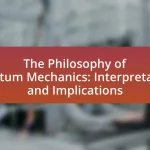The Quantum Zeno Effect is a phenomenon in quantum mechanics where frequent observation of a quantum system prevents it from evolving into a different state. This article explores the principles behind the Quantum Zeno Effect, its significance in physics, and its implications for measurement in quantum systems. It discusses key experiments that demonstrate the effect, the challenges researchers face, and the technologies used to observe particles. Additionally, the article highlights potential applications of the Quantum Zeno Effect in quantum computing, medical imaging, and quantum cryptography, emphasizing its role in stabilizing quantum states and enhancing measurement precision.

What is the Quantum Zeno Effect?
The Quantum Zeno Effect is a phenomenon in quantum mechanics where frequent observation of a quantum system prevents it from evolving into a different state. This effect occurs because the act of measurement collapses the wave function, effectively “freezing” the system in its current state. Experimental evidence supporting the Quantum Zeno Effect includes studies where particles, such as atoms or photons, were repeatedly measured, demonstrating that their state remained unchanged despite the passage of time.
How does the Quantum Zeno Effect relate to quantum mechanics?
The Quantum Zeno Effect illustrates a fundamental principle of quantum mechanics, demonstrating that frequent observation of a quantum system can inhibit its evolution. In quantum mechanics, particles exist in superpositions of states, and the act of measurement collapses these superpositions into a definite state. The Quantum Zeno Effect shows that by continuously measuring a particle, one can effectively “freeze” its state, preventing it from transitioning to other states. This phenomenon has been experimentally validated, such as in studies involving unstable particles where repeated measurements significantly increased their observed lifetimes, confirming the theoretical predictions of quantum mechanics regarding the impact of observation on quantum states.
What are the fundamental principles behind the Quantum Zeno Effect?
The fundamental principles behind the Quantum Zeno Effect state that frequent observation of a quantum system can inhibit its evolution, effectively “freezing” its state. This phenomenon arises from the interaction between the observer and the quantum system, where repeated measurements prevent the system from transitioning to other states. Experimental evidence, such as studies conducted by Misra and Sudarshan in 1977, demonstrates that continuous observation leads to a suppression of quantum state changes, confirming the effect’s validity.
How does observation influence quantum states in this effect?
Observation influences quantum states in the Quantum Zeno Effect by causing a system to remain in its initial state due to frequent measurements. When a quantum system is observed repeatedly, the act of measurement collapses its wave function, effectively preventing it from evolving into other states. This phenomenon is supported by experimental evidence, such as the work by Misra and Sudarshan in 1977, which demonstrated that continuous observation can inhibit the transition of a quantum state, thereby illustrating the Zeno effect in quantum mechanics.
Why is the Quantum Zeno Effect significant in physics?
The Quantum Zeno Effect is significant in physics because it demonstrates how frequent observation can inhibit the evolution of a quantum system, effectively “freezing” its state. This phenomenon illustrates the fundamental principles of quantum mechanics, particularly the role of measurement in determining the state of a system. Experimental evidence, such as studies conducted by Misra and Sudarshan in 1977, shows that continuous observation can prevent a particle from transitioning to a different state, thereby providing insights into quantum control and the nature of reality at the quantum level.
What implications does it have for our understanding of measurement in quantum systems?
The Quantum Zeno Effect implies that frequent measurements can prevent the evolution of quantum systems, challenging traditional notions of measurement. This phenomenon suggests that the act of measurement does not merely reveal a pre-existing state but can actively influence the system’s behavior, leading to the conclusion that measurement plays a dynamic role in quantum mechanics. Experimental evidence, such as studies demonstrating that particles can be “frozen” in a state through continuous observation, supports this understanding, indicating that the interaction between measurement and quantum states is more complex than previously thought.
How does it challenge classical intuitions about observation?
The Quantum Zeno Effect challenges classical intuitions about observation by demonstrating that frequent observation can prevent the change of a quantum state. In classical physics, observation is typically thought to reveal the state of a system without altering it; however, the Quantum Zeno Effect shows that continuous measurement can effectively “freeze” a quantum system in its current state. This phenomenon is evidenced by experiments where particles, when observed repeatedly, exhibit a significant delay in their decay processes, contradicting the classical expectation that observation merely provides information about a system’s state.

How is the Quantum Zeno Effect demonstrated experimentally?
The Quantum Zeno Effect is demonstrated experimentally through repeated measurements of a quantum system, which inhibits its evolution. In a typical experiment, a quantum state, such as a decaying atom, is subjected to frequent observations, effectively “freezing” its state and preventing it from transitioning to a different state. For instance, experiments involving trapped ions or photons have shown that by measuring the state of the system at short intervals, the decay rate can be significantly reduced, confirming the effect. These findings align with theoretical predictions and have been validated in various studies, such as those conducted by researchers at the University of California, Berkeley, which illustrate the impact of measurement frequency on quantum state stability.
What are the key experiments that illustrate the Quantum Zeno Effect?
Key experiments illustrating the Quantum Zeno Effect include the work conducted by Misra and Sudarshan in 1977, where they proposed that frequent observations can inhibit the decay of a quantum state. This theoretical foundation was later experimentally validated in 2000 by a team led by Kwiat, who demonstrated the effect using a two-level quantum system, showing that rapid measurements could effectively freeze the state of a decaying atom. Additionally, experiments involving trapped ions and photons have further confirmed the Quantum Zeno Effect, where continuous observation prevented transitions between states, reinforcing the principle that measurement impacts quantum systems.
How do these experiments measure the effect of observation on particle states?
Experiments measure the effect of observation on particle states by utilizing the Quantum Zeno Effect, which demonstrates that frequent observation can inhibit the evolution of a quantum system. In these experiments, particles are subjected to repeated measurements, and the results show that the probability of a particle transitioning to a different state decreases with increased observation frequency. For instance, studies involving unstable particles, such as those conducted by Itano et al. in 1990, revealed that continuous observation significantly prolongs the lifetime of these particles, effectively preventing their decay. This empirical evidence supports the conclusion that observation alters the behavior of quantum systems, confirming the principles of the Quantum Zeno Effect.
What technologies are used to observe particles in these experiments?
Technologies used to observe particles in experiments related to the Quantum Zeno Effect include laser systems, photodetectors, and quantum state tomography. Laser systems enable precise manipulation and measurement of particles, while photodetectors capture the emitted light from particles, allowing for real-time observation. Quantum state tomography provides a comprehensive method to reconstruct the quantum state of a system based on measurement data, ensuring that the observation does not significantly alter the state of the particles being studied. These technologies collectively facilitate the observation of quantum systems while minimizing disturbance, which is essential for studying the Quantum Zeno Effect.
What challenges do researchers face when studying the Quantum Zeno Effect?
Researchers face significant challenges when studying the Quantum Zeno Effect, primarily due to the difficulty in maintaining the precise conditions required for observation without altering the quantum state of particles. The effect relies on frequent measurements to inhibit the evolution of a quantum system, which necessitates advanced experimental setups that can perform rapid and accurate measurements. Additionally, researchers must contend with decoherence, where environmental interactions can disrupt the delicate quantum states being studied, leading to inaccurate results. The complexity of isolating systems from external influences while ensuring sufficient measurement frequency adds further layers of difficulty to experimental designs.
How do environmental factors influence experimental outcomes?
Environmental factors significantly influence experimental outcomes by affecting the behavior and properties of quantum systems. For instance, temperature fluctuations can alter the energy states of particles, impacting their observable characteristics. Additionally, external electromagnetic fields can induce changes in particle trajectories, thereby affecting measurement results. Research has shown that in quantum mechanics, the presence of an observer or measurement apparatus can collapse a particle’s wave function, demonstrating that environmental interactions play a crucial role in determining the state of a system. This phenomenon is exemplified in the Quantum Zeno Effect, where frequent observations can inhibit the evolution of a quantum state, illustrating the profound impact of environmental conditions on experimental results.
What are the limitations of current experimental setups?
Current experimental setups for observing the Quantum Zeno Effect face several limitations, including technological constraints, measurement precision, and environmental interference. Technological constraints arise from the inability to maintain the necessary conditions for prolonged observation without altering the state of particles. Measurement precision is often hindered by the limitations of available detection methods, which can introduce noise and affect the accuracy of results. Environmental interference, such as vibrations and electromagnetic fields, can disrupt the delicate balance required for observing quantum states, leading to unreliable data. These factors collectively restrict the effectiveness of current experimental setups in fully realizing the potential of the Quantum Zeno Effect.

What are the applications of the Quantum Zeno Effect?
The Quantum Zeno Effect has applications in quantum computing, quantum information processing, and the stabilization of quantum states. In quantum computing, it can be used to protect qubits from decoherence by frequently measuring their states, thereby prolonging their coherence time. Research by Kwiat et al. (1995) demonstrated that repeated measurements could effectively freeze the evolution of a quantum system, which is crucial for maintaining information in quantum systems. Additionally, the Quantum Zeno Effect is utilized in quantum error correction protocols, enhancing the reliability of quantum computations by preventing unwanted transitions between states.
How can the Quantum Zeno Effect be utilized in quantum computing?
The Quantum Zeno Effect can be utilized in quantum computing to stabilize qubits and prevent unwanted decoherence. By frequently measuring a qubit, its state can be effectively “frozen,” thereby maintaining its quantum information for longer periods. This principle is supported by experimental evidence, such as studies demonstrating that repeated measurements can inhibit the evolution of a quantum system, allowing for more reliable quantum computations.
What role does it play in error correction within quantum systems?
The Quantum Zeno Effect plays a crucial role in error correction within quantum systems by enabling frequent measurements that prevent the evolution of quantum states. This effect allows for the stabilization of qubits, which are the fundamental units of quantum information, by continuously observing them, thereby reducing the likelihood of decoherence and errors. Research has shown that repeated measurements can effectively “freeze” the state of a quantum system, maintaining its integrity and enhancing the reliability of quantum computations. This principle is essential for developing robust quantum error correction codes, which are necessary for practical quantum computing applications.
How might it enhance the stability of qubits?
The Quantum Zeno Effect enhances the stability of qubits by allowing frequent measurements to prevent their state from evolving. This phenomenon occurs because continuous observation effectively “freezes” the qubit’s state, reducing the likelihood of decoherence, which is a major source of instability in quantum systems. Research has shown that by applying rapid measurements, qubits can maintain their quantum state for longer periods, thereby improving their reliability for quantum computing applications. For instance, a study published in Nature by researchers at the University of California demonstrated that qubits subjected to the Quantum Zeno Effect exhibited significantly lower error rates compared to those not observed frequently.
What potential applications exist in other fields?
The Quantum Zeno Effect has potential applications in fields such as quantum computing, where it can enhance error correction by stabilizing qubit states during computation. This effect allows for the observation of quantum states without causing significant disturbance, which is crucial for maintaining coherence in quantum systems. Additionally, in the field of medical imaging, the Quantum Zeno Effect could improve techniques like MRI by enabling more precise measurements of quantum states, potentially leading to better diagnostic tools. Research indicates that utilizing this effect can lead to advancements in both technology and healthcare, demonstrating its versatility across various disciplines.
How could the Quantum Zeno Effect impact medical imaging technologies?
The Quantum Zeno Effect could significantly enhance medical imaging technologies by allowing for the observation of particles without altering their states, thereby improving image clarity and accuracy. This effect, which states that frequent observation can prevent the evolution of a quantum system, can be applied to techniques like MRI and PET scans. For instance, by utilizing rapid measurement techniques, the Quantum Zeno Effect could minimize the disturbance of quantum states in biological tissues, leading to more precise imaging of cellular structures. Research indicates that such advancements could lead to earlier detection of diseases, as clearer images allow for better differentiation between healthy and pathological tissues.
What are the implications for quantum cryptography?
Quantum cryptography has significant implications for secure communication, primarily through the use of quantum key distribution (QKD). QKD leverages the principles of quantum mechanics, ensuring that any attempt to eavesdrop on the communication alters the quantum state of the transmitted information, thereby alerting the communicating parties to the presence of an intruder. This property is rooted in the no-cloning theorem, which states that quantum information cannot be copied without detection. As a result, quantum cryptography offers a theoretically unbreakable method of securing data transmission, making it a crucial advancement in the field of cybersecurity.
What practical considerations should researchers keep in mind when exploring the Quantum Zeno Effect?
Researchers exploring the Quantum Zeno Effect should prioritize the precision of measurement techniques, as the effect relies on frequent observations to inhibit quantum state changes. Accurate timing and control of measurement intervals are crucial; studies indicate that the effectiveness of the Zeno effect diminishes with longer intervals between measurements. Additionally, researchers must consider the impact of environmental factors, such as decoherence, which can disrupt the delicate quantum states being observed. Experimental setups should minimize external noise and maintain isolation from perturbations to ensure reliable results. Furthermore, understanding the theoretical framework behind the Quantum Zeno Effect is essential, as it informs the design of experiments and the interpretation of data.




